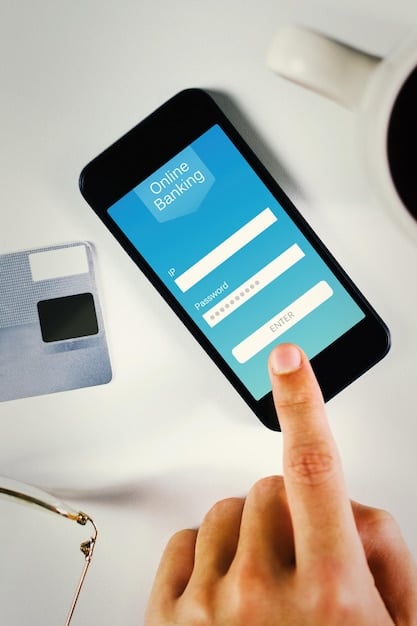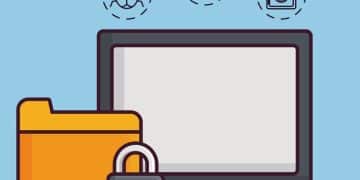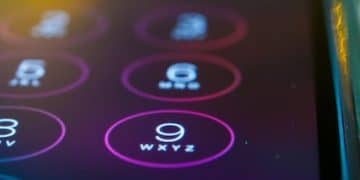Secure Your Bank Account: How to Set Up MFA in Under 10 Minutes (2025 Update)

Securing your financial assets online is paramount, and activating Multi-Factor Authentication on your bank account in under 10 minutes (2025 Update) provides a critical layer of defense against unauthorized access, safeguarding your financial information with robust, modern security protocols.
In today’s digital landscape, the security of your bank account is more critical than ever. As cyber threats evolve, so too must our defenses. Discover how to enhance your financial security by setting up Multi-Factor Authentication on your bank account in under 10 minutes (2025 Update), a simple yet powerful step towards protecting your digital wealth.
The Urgency of Enhanced Bank Account Security in 2025
The digital age, while offering unparalleled convenience, has also ushered in a new era of sophisticated cyber threats. As we move further into 2025, the tactics employed by cybercriminals are becoming increasingly advanced, making traditional password-based security measures insufficient. Your bank account, the cornerstone of your financial life, presents a particularly tempting target for those looking to exploit vulnerabilities. This necessitates a proactive and robust approach to security.
Understanding the evolving threat landscape is the first step towards better protection. Phishing scams, malware, and credential stuffing attacks are no longer abstract concepts; they are daily realities that can compromise even the most vigilant users. Financial institutions continually invest in fortifying their systems, but the ultimate responsibility for securing your individual account often falls within your control, starting with the implementation of Multi-Factor Authentication (MFA).
Why traditional passwords are no longer enough
For decades, passwords have been the primary gatekeepers of our digital lives. However, their inherent weaknesses have become glaringly apparent. Passwords can be:
- Guessed or Brute-Forced: Weak or common passwords are easily compromised by automated attacks.
- Phished: Sophisticated scams trick users into revealing their credentials on fake websites.
- Stolen via Data Breaches: Large-scale breaches expose millions of passwords, which are then sold on the dark web.
- Reused: Many individuals reuse the same password across multiple platforms, creating a single point of failure.
Each of these vulnerabilities underscores the critical need for an additional layer of security beyond just a password.
The cost of compromised accounts
The repercussions of a compromised bank account extend far beyond immediate financial loss. While the primary concern is often the theft of funds, the aftermath can include:
- Identity Theft: Cybercriminals can use stolen financial information to open new lines of credit or accounts in your name.
- Credit Score Damage: Fraudulent activities can negatively impact your credit rating, making it difficult to obtain loans or mortgages.
- Emotional Distress: The process of recovering stolen funds, closing compromised accounts, and dealing with identity theft can be emotionally taxing and time-consuming.
- Loss of Trust: A breach can erode trust in online banking systems, leading to a reluctance to use convenient digital services.
Given these significant potential costs, the minimal effort required to set up MFA pales in comparison to the peace of mind and protection it offers.
In essence, embracing enhanced security measures like MFA is not merely an optional step; it’s a fundamental requirement in 2025 to safeguard your financial well-being against an ever-present and evolving array of cyber threats. By taking action now, you’re investing in your future security.
Understanding Multi-Factor Authentication (MFA)
Multi-Factor Authentication, or MFA, is a security system that requires two or more verification methods from independent categories of credentials to verify a user’s identity for a login or other transaction. Rather than just relying on a password, which is something you know, MFA introduces additional “factors” to confirm it’s truly you attempting to access your account. This layered approach significantly reduces the risk of unauthorized access, even if your password falls into the wrong hands.
The core principle behind MFA is simple: an attacker would need to compromise multiple, distinct security elements to gain access. This makes their task exponentially more difficult and provides a much stronger barrier against cybercriminals. As technology advances, the types of factors used in MFA are also diversifying, offering greater flexibility and robustness in securing online interactions.
The three pillars of authentication
MFA typically relies on a combination of different types of authentication factors. These are generally categorized into three distinct pillars:
- Something You Know (Knowledge Factor): This is the most common factor and includes things like passwords, PINs, security questions, or passphrases. It relies on information that only the legitimate user is supposed to be aware of.
- Something You Have (Possession Factor): This factor involves an item physically in your possession. Examples include a mobile phone (for SMS codes or authenticator apps), a hardware security key (like a YubiKey), or a smart card. The idea is that an unauthorized user would not possess this physical item.
- Something You Are (Inherence Factor): This refers to unique biological characteristics. Biometric authentication falls into this category, such as fingerprint scans, facial recognition, iris scans, or voice recognition. These methods are highly personal and difficult to replicate.
By combining at least two of these factors, MFA creates a highly resistant security framework. For instance, a common MFA setup for banking involves “something you know” (your password) and “something you have” (a one-time code sent to your phone).
Common MFA methods for banking
Financial institutions employ various MFA methods to balance security with user convenience. Some of the most prevalent options you’ll encounter for bank accounts include:
- SMS One-Time Passcodes (OTP): A temporary numerical code sent to your registered mobile phone via text message. This is often the simplest and most widely supported form of MFA.
- Authenticator Apps: Applications like Google Authenticator, Microsoft Authenticator, or Authy generate time-based one-time passcodes (TOTP) directly on your smartphone. These codes refresh every 30-60 seconds and don’t require network connectivity once set up.
- Hardware Security Keys: Physical devices that generate codes or use cryptographic keys to verify your identity. These are often considered the most secure option as they are phishing-resistant.
- Biometrics: Using your fingerprint or facial scan on your smartphone or computer as an authentication factor, often integrated directly into banking apps.
- Email One-Time Passcodes: Similar to SMS OTPs, but the code is sent to your registered email address. While convenient, this method is slightly less secure if your email account itself is compromised.
Each method offers varying levels of security and convenience, and your bank may offer a selection to choose from. Understanding these options helps you select the most suitable MFA method for your personal preferences and needs, ensuring both robust security and ease of access.
In conclusion, MFA is not an over-complicated security measure but a fundamental enhancement designed to protect your most valuable digital assets. Its layered approach significantly raises the bar for cybercriminals, making your account far more difficult to compromise than with a password alone.
Preparations Before You Start: What You Need
Before you dive into setting up Multi-Factor Authentication for your bank account, a few simple preparations can make the process go smoothly and quickly. Thinking ahead about what you’ll need can help you complete the setup in under 10 minutes, avoiding any unnecessary delays or frustration. This proactive approach ensures you have all the necessary tools and information at your fingertips, making the security enhancement process seamless.
A little front-end effort can save a lot of time and potential headaches during the setup. By gathering your essentials, you’re not just preparing for the process; you’re actively setting yourself up for success in securing your account efficiently.
Essential items and information
To ensure a swift and successful MFA setup, gather the following:
- Your Bank Account Login Credentials: This includes your username and password, as you’ll need to log into your online banking portal to initiate the MFA setup.
- Your Smartphone: Most MFA methods rely on your mobile device. Ensure it’s charged and has a stable internet connection (Wi-Fi or cellular data).
- Your Registered Phone Number and Email Address: Verify that the phone number and email address associated with your bank account are current and accessible. Many banks use these for sending verification codes.
- A Good Internet Connection: A reliable connection will prevent timeouts or interruptions during the setup process.
Having these items ready before you begin will streamline the entire procedure.
Updating contact information with your bank
An often-overlooked but crucial step is ensuring your bank has your most up-to-date contact information. If your registered phone number or email address is old, you won’t receive the necessary verification codes, halting the MFA setup in its tracks. Before attempting to enable MFA:
- Log into your online banking platform: Navigate to your profile or settings section.
- Review your contact details: Check your registered phone number and email address.
- Update if necessary: If any information is outdated, update it immediately. This might involve a separate verification step by the bank to confirm your identity.
Confirming your contact details ensures that the bank can communicate with you effectively for MFA purposes and other essential account notifications. This preparation phase is fundamental to a quick and hassle-free MFA activation, paving the way for enhanced security on your bank account without any unexpected delays once you begin the actual process.

Step-by-Step Guide: Activating MFA on Your Bank Account
Now that you’re prepared, let’s walk through the process of activating Multi-Factor Authentication for your bank account. While specific steps may vary slightly between financial institutions, the general procedure outlined here will be consistent across most major banks. Our goal is to make this straightforward so you can complete it quickly and effectively, enhancing your security in under 10 minutes.
The beauty of this process is its relative simplicity for the profound security benefits it provides. Follow these steps methodically, and you’ll fortify your bank account against many common cyber threats without consuming much of your valuable time.
1. Log into your online banking portal
The very first step is to access your bank account through its official online portal. Always ensure you are on the legitimate website by checking the URL for “https://” and looking for a padlock icon in your browser’s address bar.
- Open your web browser: Navigate to your bank’s official website. Avoid clicking on links from emails or unverified sources.
- Enter your username and password: Use your established login credentials to access your account dashboard.
2. Navigate to security or profile settings
Once logged in, you’ll need to find the section dedicated to security or profile management. This is where most banks house their MFA options.
- Look for “Security,” “Settings,” “Profile,” or “Preferences”: These are common labels for the section containing security features. It might be located in a top-menu bar, a sidebar, or under a dropdown menu associated with your name or account.
- Find “Multi-Factor Authentication,” “Two-Factor Authentication (2FA),” or “Login Security”: Within the security settings, locate the specific option for MFA. Some banks might refer to it as 2FA.
3. Choose your preferred MFA method
Your bank will likely offer a few MFA options. Select the one that best suits your convenience and security preferences.
Popular MFA Methods and How to Choose
- SMS Passcodes (OTP): This is often the easiest. If you choose this, the bank will typically send a test code to your registered phone number to verify it’s correct. Enter this code to confirm setup.
- Authenticator App: This method is generally more secure than SMS.
- Download a trusted authenticator app (e.g., Google Authenticator, Microsoft Authenticator, Authy) to your smartphone.
- On your bank’s website, an option to add a new device or app will display a QR code.
- Open your authenticator app and use its “scan a QR code” feature to scan the code displayed on your computer screen. This links your banking app to the authenticator.
- The authenticator app will then generate a 6-digit code. Enter this code back into your bank’s website to complete the setup.
- Biometrics (Fingerprint/Face ID): If using a mobile banking app that supports biometrics, you might enable this directly within the app’s settings. The setup usually involves confirming your identity and then registering your fingerprint or face through your phone’s native biometric scanner.
After selecting your method, the bank will guide you through a series of prompts to complete the setup. Essentially, you’re just confirming that your chosen second factor (your phone, an app) is indeed connected and accessible to you.
4. Review and confirm MFA settings
Once you’ve gone through the steps to link your chosen MFA method, the bank will ask you to confirm your selection and often provide a summary of your new security settings.
- Confirm activation: Ensure that the MFA feature is toggled to “On” or “Enabled.”
- Save changes: Don’t forget to click “Save,” “Apply,” or “Confirm” to finalize your settings.
Congratulations! You have successfully added an extra layer of protection to your bank account. The next time you log in, you will be prompted for both your password and a code from your chosen MFA method, significantly enhancing your financial security with minimal effort.
Troubleshooting Common MFA Setup Issues
While setting up Multi-Factor Authentication for your bank account is typically a smooth process, minor hiccups can occur. Knowing how to troubleshoot common issues can save you time and frustration, ensuring you complete the setup efficiently. Problems often stem from simple oversights rather than complex technical failures, and addressing them is usually straightforward.
Don’t be discouraged if you encounter a snag; these are common, and in most cases, a quick check of your settings or actions will resolve the issue. The goal is to get your MFA up and running as quickly as possible to secure your account.
Common problems and quick fixes
- Not receiving SMS codes:
- Check your phone number: Ensure your registered phone number with the bank is correct and up-to-date.
- Signal issues: Verify you have good cellular signal strength.
- Spam filter: Check your phone’s spam or junk message folder.
- Delay: Sometimes, there’s a short delay. Wait a minute or two before requesting a new code.
- Authenticator app codes not working:
- Time synchronization: The most common issue. Ensure your phone’s date and time are set to “automatic” or “network-provided.” Authenticator apps rely on accurate time synchronization.
- Incorrect QR code scan: If you initially scanned a blurry or incorrect QR code, try re-linking the app by removing the existing entry and scanning the QR code again from your bank’s website.
- Biometrics failing:
- Clean sensor/camera: Ensure your fingerprint sensor or face ID camera is clean and unobstructed.
- Lighting (for Face ID): Ensure you are in adequate lighting conditions for facial recognition.
- Re-register biometric: If persistent issues, try re-registering your fingerprint or face within your phone’s security settings.
- Browser issues:
- Clear cache/cookies: Sometimes, browser data can interfere. Clear your browser’s cache and cookies.
- Try a different browser: If one browser is consistently problematic, try another (e.g., Chrome, Firefox, Edge, Safari).
- Disable extensions: Temporarily disable browser extensions that might interfere with scripts or security features.
When to contact your bank’s support
If you’ve tried the common troubleshooting steps and are still facing difficulties, it’s time to reach out to your bank’s customer support. They have specialized tools and knowledge to assist with account-specific issues.
- Account lockouts: If you’re locked out due to too many failed MFA attempts.
- Unrecognized activity: If you receive an MFA prompt but did not initiate a login attempt.
- Persistent errors: If you continuously receive error messages that don’t seem to relate to the common issues above.
- Lost or stolen device: Immediately contact your bank if the device used for MFA (your phone, hardware key) is lost or stolen.
When contacting support, be prepared to verify your identity through other means (e.g., security questions, account details). Providing clear details about the issue you’re experiencing will help them assist you more efficiently. Remember, their primary goal is to help you secure your account, so don’t hesitate to seek their assistance if needed. Resolving these issues promptly ensures your account remains protected with the full force of MFA.
Best Practices for Maintaining Bank Account Security with MFA
Activating Multi-Factor Authentication is a crucial first step, but maintaining robust bank account security requires ongoing vigilance and adherence to best practices. MFA significantly enhances your protection, but it’s not a silver bullet. A comprehensive approach involves combining MFA with smart digital habits both with your financial institution and across your online presence. In 2025, security is an active process, not a one-time setup.
Implementing MFA empowers you with a stronger defense, but its effectiveness is amplified when coupled with proactive measures. These practices ensure that the layers of security you’ve established remain impenetrable against evolving cyber threats.
Beyond the initial setup: ongoing vigilance
- Never share your MFA codes: Your bank will never ask you for your one-time verification codes over the phone, email, or text. Treat these codes as sensitive as your password.
- Be wary of phishing attempts: Always double-check the sender of any email or text message requesting account information or verification codes. Assume such requests are suspicious and verify directly with your bank using an official contact method.
- Regularly review account activity: Make it a habit to periodically log into your online banking and scrutinize your transaction history for any unauthorized activity. Utilize your bank’s notification features to receive alerts for large transactions or logins from new devices.
- Keep your contact information updated: Ensure your bank always has your current phone number and email address, as these are critical for MFA and fraud alerts.
Protecting your MFA device and recovery options
Your MFA device (smartphone, hardware key) is now a critical component of your bank account’s security. Protect it as diligently as you protect your wallet and identity documents.
Device Security Best Practices
- Use a strong PIN/Passcode on your phone: If your phone falls into the wrong hands, a strong device passcode prevents unauthorized access to your authenticator apps or SMS messages.
- Keep your authenticator apps secure: Some authenticator apps offer their own PIN or biometric lock. Enable these features for an extra layer of protection.
- Do not jailbreak or root your device: Modifying your smartphone’s operating system compromises its built-in security features, making it more vulnerable to malware.
- Be mindful of public Wi-Fi: Avoid accessing your banking apps or sensitive information over unsecured public Wi-Fi networks where data could be intercepted.
- Backup your recovery codes (if applicable): Some MFA methods (especially authenticator apps) provide recovery codes in case you lose your device. Store these codes securely offline, such as in a safe or encrypted password manager, separate from your bank login.
By integrating these best practices into your routine, you transform your MFA setup from a static defense into a dynamic security system. Proactive awareness and consistent adherence to these guidelines are the hallmarks of a truly secure financial life in the digital age, ensuring your bank account remains protected well into 2025 and beyond.
The Future of Bank Account Security: What to Expect in 2025 and Beyond
As we navigate through 2025, the landscape of bank account security is continuously evolving, driven by advancements in technology and the persistent threat of cybercrime. While Multi-Factor Authentication is currently a cornerstone of digital security, financial institutions and tech innovators are tirelessly working on the next generation of protective measures. Understanding these emerging trends can help you stay ahead of the curve and recognize new enhancements as they become available.
The goal remains constant: to make online banking as secure and user-friendly as possible. This involves moving towards more seamless, yet increasingly robust, authentication experiences that leverage new technological capabilities while mitigating the risk posed by sophisticated attackers.
Beyond traditional MFA: emerging trends
- Passwordless Authentication: A significant shift is towards completely removing passwords. This involves relying solely on strong MFA methods like biometric scans or FIDO2 security keys, often combined with device authentication. This eliminates the risk associated with password theft.
- Behavioral Biometrics: This involves continuously authenticating users based on how they interact with their devices—their typing rhythm, mouse movements, swipe patterns, and even how they hold their phone. This passive authentication adds a powerful layer of security without requiring active input from the user.
- Artificial Intelligence (AI) and Machine Learning (ML) for Fraud Detection: Banks are increasingly using AI and ML to analyze vast amounts of data in real-time, identifying unusual patterns or anomalies that could indicate fraudulent activity. This proactive detection can flag suspicious transactions before they cause significant damage.
- Quantum-Resistant Cryptography: As quantum computing advances, there’s a growing need for cryptographic methods that can withstand the immense computational power of quantum computers. Research and development in this area will ensure long-term data security against future threats.
- Decentralized Identity Solutions: While still in early stages, blockchain-based decentralized identity solutions could give individuals more control over their personal data, making it harder for centralized systems to be compromised and credentials stolen for financial fraud.
These innovations aim not only to bolster security but also to enhance the user experience by making authentication less intrusive and more intuitive. The emphasis is on layered, invisible security that protects without impeding legitimate access.
Staying ahead of the curve
To ensure your bank account remains secure in the evolving digital environment, consider these forward-looking actions:
- Embrace New Security Features: As your bank rolls out new security features, such as passwordless login options or advanced biometric authentication, be proactive in adopting them.
- Educate Yourself: Stay informed about the latest cyber threats and security best practices. Reputable financial news outlets and your bank’s security advisories are good sources.
- Hardware Security Keys: Consider investing in a hardware security key (e.g., YubiKey) for your most critical accounts, including banking. These offer superior phishing resistance compared to SMS or even authenticator apps.
- Dedicated Device for Banking: For extremely high-value accounts, some individuals consider using a dedicated device (e.g., a spare smartphone or tablet) solely for banking and other sensitive financial transactions, minimizing exposure to other apps and risks.
The future of bank account security is one of continuous adaptation and innovation. By understanding the current landscape and anticipating future developments, you can ensure your financial well-being remains protected against the always-on, ever-evolving world of cyber threats. Staying informed and open to adopting new security measures will be paramount in 2025 and beyond.
Common Misconceptions About Bank Account Security
Despite increased awareness, several misconceptions about bank account security persist, potentially leaving individuals vulnerable to cyber threats. Dispelling these myths is crucial for adopting truly effective security practices. Many believe that basic precautions are enough, or that banks bear the sole responsibility for account security, leading to a false sense of safety. However, a secure financial life online requires a clear understanding of personal responsibility and the limitations of different security measures.
Addressing these common misunderstandings can empower users to make more informed decisions about their digital security. It’s about recognizing that while banks do their part, user action plays an equally critical role in preventing fraud and unauthorized access.
Myth vs. reality: setting the record straight
Myth: My bank protects me completely.
- Reality: While banks employ advanced security systems, firewalls, and fraud detection, their protection is limited to their infrastructure. Many breaches exploit human error, such as falling for phishing scams or using weak passwords. Your bank can’t protect something you willingly give away or if your personal device is compromised. Security is a shared responsibility.
Myth: My password manager makes my accounts foolproof.
- Reality: Password managers are excellent tools for creating strong, unique passwords and storing them securely. However, if your master password for the manager is weak, or if your device is severely compromised by malware that bypasses the manager’s security, your accounts can still be at risk. Password managers are a crucial layer, but not the only one. MFA remains essential.
Myth: Public Wi-Fi is fine for banking if I’m just checking balances.
- Reality: Public Wi-Fi networks (e.g., at coffee shops or airports) are often unencrypted and unsecured. Cybercriminals can easily intercept data transmitted over these networks, including your login credentials or sensitive financial information. Always use a Virtual Private Network (VPN) or your mobile data (which is more secure) when accessing sensitive accounts on public Wi-Fi.
Myth: I don’t need MFA if I have multifactor authentication (2FA) already.
- Reality: The terms MFA (Multi-Factor Authentication) and 2FA (Two-Factor Authentication) are often used interchangeably. 2FA is a specific type of MFA that uses exactly two factors. All 2FA is MFA, but not all MFA is 2FA (some systems might use three or more factors). If you have 2FA set up, you are already using a form of MFA and are significantly more secure than with just a password. The advice here applies directly to enhancing your existing 2FA/MFA or setting it up if you haven’t.
Myth: If I just use my phone’s fingerprint/Face ID, I don’t need anything else.
- Reality: Biometric authentication (fingerprint/Face ID) is a convenient and strong form of authentication. However, if it’s the *only* factor protecting your banking app without an underlying password or PIN (which is rare for a banking app), and your device itself is compromised, it could theoretically be bypassed. Most banking apps integrate biometrics as one of the MFA factors, alongside “something you know” (your banking password/PIN) or “something you have” (the unique device itself). Rely on your bank’s recommended setup which usually combines these.
By dispelling these common misconceptions, you can build a more realistic and robust personal security posture. True bank account security in 2025 stems from layered defenses, constant vigilance, and an understanding that your actions are as critical as your bank’s systems in safeguarding your financial assets.
| Key Takeaway | Brief Description |
|---|---|
| 🔒 Enhanced Security | MFA adds a critical layer beyond just a password, making unauthorized access significantly harder. |
| ⏱️ Quick Setup | Activating MFA typically takes under 10 minutes with proper preparation. |
| 📱 Device Dependency | Most MFA methods rely on your smartphone; ensure it’s secure and updated. |
| vigilant | Ongoing vigilance, like protecting recovery codes, is key for continuous protection. |
Frequently Asked Questions About Bank Account MFA
MFA is a security system requiring two or more verification methods to confirm your identity. It’s crucial for bank accounts because it adds layers of security beyond just a password, significantly protecting against unauthorized access, even if your password is stolen. This layered defense dramatically reduces your risk of financial fraud and identity theft in a constantly evolving threat landscape.
Typically, banks allow you to select one primary MFA method (e.g., SMS, authenticator app, or biometrics) for standard daily logins. However, they often have backup methods, like security questions or email codes, for specific situations such as account recovery or logging in from an unrecognized device, providing flexibility and an alternative if your primary method is unavailable.
While convenient and widely adopted, SMS for MFA is generally considered less secure than authenticator apps or hardware keys due to vulnerabilities like SIM swapping. However, for most users, it still offers substantially greater protection than no MFA at all. For maximum security, authenticator apps or physical keys are recommended if your bank supports them.
If you lose your MFA device (like your smartphone), immediately contact your bank’s customer support. They will have a process for verifying your identity and deactivating the old MFA method, allowing you to set up a new one on a different device. Having recovery codes or alternative contact methods registered with your bank can greatly expedite this process.
MFA adds a very slight step to your login, requiring you to enter a code or approve a prompt. However, this momentary addition is a minimal trade-off for the substantial increase in security. Most MFA processes are designed to be quick and efficient, often taking only a few extra seconds, a small price to pay for safeguarding your financial assets.
Final Thoughts: Your Role in a Secure Financial Future
In a world increasingly driven by digital convenience, the security of your financial assets rests significantly on the proactive steps you take. Setting up Multi-Factor Authentication on your bank account is not just a recommendation in 2025; it’s an essential measure that fortifies your defenses against sophisticated cyber threats. This guide has shown that enhancing your security can be done efficiently, often in under ten minutes, providing immediate and tangible benefits in protecting your digital life. Remember, security is an ongoing commitment, and staying informed, vigilant, and ready to adapt to new technologies is your best strategy for a secure financial future.





